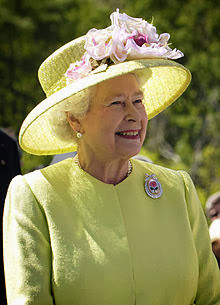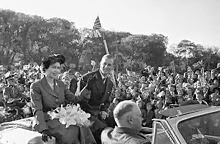Born in 1926, Queen Elizabeth II was crowned head of state, when she was just 25 years old - after the death of her father, George IV, in 1952. Queen Elizabeth is now the second longest serving British monarch and has presided over half a century of continual change both within the Royal Family, Britain and the Commonweath.
Elizabeth was the eldest child of Prince Albert, the Duke of York (later George VI) and his wife Elizabeth (later known as the Queen Mother). Her father Prince Albert was second in line to the throne, until his elder brother Edward VIII abdicated in 1936 - pushing the shy Prince Albert into an unexpected role of King. King George VI rose to the challenge though he died early in 1952.
Elizabeth was educated at home, along with her sister Princess Margaret. During the Second World War, they were evacuated to Balmoral and later Windsor Castle. Towards the end of the war in 1945, Elizabeth joined the womens Royal Auxilliary Territorial Service, where she served as a driver and mechanic. After the war, she increasingly stepped into her role of performing public service, and made her first overseas trip to South Africa in 1947. Shortly before her 21st birthday, she said:
"I declare before you all that my whole life, whether it be long or short, shall be devoted to your service and the service of our great imperial family to which we all belong."
In 1952, her father, George VI passed away and Queen Elizabeth was crowned to widespread enthusiasm. Her coronation set TV records around the globe, and it appeared to usher in a new era for the monarchy and British Commonwealth. News of Edmund Hilary reaching the peak of Mt Everest were delayed to co-incide with her coronation. It appeared a symbolic end to the post-war austerity.
The 1950s could be seen as the golden age for the Queen. Deference and respect to the Royal family were still high, and the young Elizabeth looked like the fairytale Princess. However, over the next few decades, widespread social change saw a decline in traditional attitudes to the monarchy. Also the new era of TV and intense media scrutiny led to many unfavourable headlines as her children were caught up in marital problems and related scandals.
Yet, there were still high points for the Royal Family, such as her 'Silver Jubiliee' in 1977 and the wedding of Prince Charles and Lady Diana in 1981. By the 1990s, the media had a widespread fascination with Princess Diana, but as their marriage broke down, the Queen was increasingly perceived as being out of touch. In 1992, she famously declared the year to be her 'annus horribilus'
1992 is not a year on which I shall look back with undiluted pleasure. In the words of one of my more sympathetic correspondents, it has turned out to be an 'Annus Horribilis'. (Christmas address)- With media headlines dominated by the marriage breakup of Charles and Diana, a fire in Windsor, and other criticisms. In 1996, Princess Diana died in a car crash, and temporarily there was public dismay as the Queen appeared distant and refused to fly flag at half mast. But, after the Queen later expressed admiration for Princess Diana the hostility evaporated. Nevertheless, the relationship between Princess Diana and the Queen were best described as being 'cool'.
The Queen placed great emphasis on her job as uniting the Commonwealth - a difficult job in the post war period as de-colonisation led to many differing problems. However, the Queen usually received widespread acclaim, and many say she was a real unifying presence at the Commonwealth meetings. In a speech at the United Nations, in 2010 she spoke of the importance of countries working together:
In tomorrow's world we must all work together as hard as ever, if we're truly to be United NationsAfter the difficulties of the 1990s, the 2000s saw a resurgence in her popularity as the Royal Family put many difficulties behind them, and they were able to celebrate good news. If 1992 was her annus horribilus, 2012, was perhaps her annus mirabilis. Firstly, in April, Prince William married Kate Middleton to widespread public support. Then in summer, her golden jubilee was widely celebrated and popular despite the wet weather. Finally in July 2012, she took part in the opening ceremony of the London Olympics - which was a huge global sucess.
Despite nearing the age of 81 she appears remarkably mobile, and shows no sign of passing the throne to Charles early.




No comments:
Post a Comment